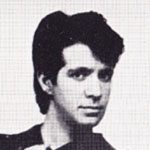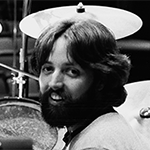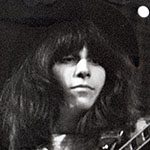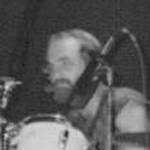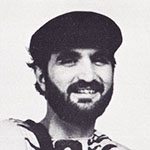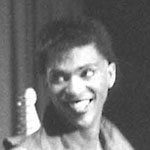
Nyle Steiner
Inventor, The EVI Steiner
Matt Traum:
Studio musician and electronic musical instrument developer Nyle Steiner is the inventor of the Electronic Valve Instrument (EVI) and Electronic Wind Instrument (EWI). Steiner originally conceived of the concept of a brass-style electronic synthesizer in the 1960s. He immediately began prototyping the concept into the early 1970s when, in 1975, Steiner completed his first playable Electric Valve Instrument or EVI.
The EVI allowed trumpet players to expand their sound palate and control electronic musical synthesizers and other devices not with a keyboard as was the norm, but with a trumpet-like fingering system which they were already familiar with. In the mid 1970s, Nyle Steiner set up a small Salt Lake City Utah based synthesizer company named Steiner-Parker with Dick Parker and a third partner. The company produced the original Steiner EVI as well as various analog synthesizers from approximately 1975 to 1980. Steiner’s early instruments were individually hand made by Nyle Steiner himself. An Electronic Wind Instrument (EWI) woodwind version, also called the Steinerphone, was developed soon after as sax players learned of this new invention and also wanted to join in the exciting new technology. One of the earliest commercial recordings of the EVI was by Bruce Cassidy on the Blood, Sweat, and Tears recording of “Nuclear Blues”.
Steiner’s original EVI model was simply a controller interface, and thusly made no sound on its own. It was designed to be connected to a synthesizer. Steiner often paired it up with their Steiner MicroCon analog synthesizer box. The control interface of the earliest EVI was very basic consisting of three switches on top of the instrument for the “valves”, a two and a half inch canister which the left hand twisted to select the octave, a single button on the canister to split the octave in half lowering the pitch a fourth, and a simple on/off switch that was controlled from the player’s breath. The earliest EVI models did this by means of a balloon inside the EVI’s body that pushed against a switch to turn the sound on and off. The EVI was connected to a synthesizer by means of control voltage (CV) signals- one for pitch and one for gate. Steiner states, “I developed my own transducer using whatever- I tried a lot of things out. A lot of the main parts I had to build myself. The first one was just a switch. You blew and it turned on and off – just like pressing a key. Later I built a proportional transducer.” As Steiner mentions, he later designed a proportional breath sensor as a way to send a CV signal that responded to the varying levels of the player’s breath pressure for a far more expressive performance. He also later developed methods and sensors that would respond to bending pitch, adding vibrato, and controlling glide between notes.
In 1979 Steiner-Parker dissolved but Steiner continued on making electronic music products and continuing to develop the EVI and EWI. Around this time Steiner collaborated with the Italian electronic musical instrument company Crumar and in 1980 Crumar released the Steiner / Crumar EVI. This all-analog model EVI is based on the then popular CEM3340 and SSM2040 synth chips and it has a gorgeous big sound. Around this time, Nyle’s career was beginning to take some new turns. In 1979 he worked on the movie Apocalypse Now while commuting from Salt Lake City. He demonstrate the EVI for the producers and they really liked the sound. Nyle soon after moved to California and began to make a career for himself playing in the studios on many large budget major motion pictures including Apocalypse Now, The Color Purple, Dead Poets Society, Fatal Attraction, Ghost, Officer And A Gentleman, Police Academy III, Pretty In Pink, Star Trek III, The Search for Spock, Twins, Witness, and others. Nyle Steiner’s TV recording work includes Cagney & Lacy, Columbo, Dallas, Fantasy Island, Knott’s Landing (solo on main theme), Matlock, Perry Mason, Quincy, Remington Steele, St. Elsewhere, and many others. Over the years, Steiner has also performed on recordings with the top names in the music business including Barbra Streisand and Neil Diamond. Be sure to see the RECORDINGS section of the Nyle Steiner Homepage link below for a brief list of Steiner’s amazing body of recorded work.
Although many people have never heard of the EVI instrument, most people have certainly heard the EVI without knowing it. Steiner states, “Most of the film composers use EVI in one way or another – it’s really good as an expressive melody instrument; the vibrato flexibility, the bending – it’s really easy to play that way.”
In 1980, Steiner travelled to Austria and won the Linz prize for his EVI invention. With the introduction of the MIDI standard in the early 1980s, Steiner began to explore the use of MIDI to control synthesizers instead of control voltage (CV). In designing the original EVI, Steiner comments, “I found it was best to design my own synthesizer. With MIDI and some of the more advanced designs, there are some synthesizers that work pretty well with it without having to modify them, but it used to be that I had to modify the synthesizers so much that I just gave up and designed my own.” As MIDI became more popular, Steiner made a few interface boxes that converted the older CV type control signals to MIDI opening up a world of sounds the lucky few who had these boxes. To do this, Steiner converted and modified a handful of JL Cooper WindDriver boxes to interface with the Crumar EVIs and Steinerphone EVIs and EWIs. These were used by top studio musicians of the time including Michael Brecker, Judd Miller, Joel Peskin, Fred Seldon, and Doug Norwine.
The Japanese-based Akai company licensed the original EVI and EWI designs from Steiner in 1986 and released the Akai EVI1000 and EWI1000 controllers with their required companion Akai EWV2000 sound module in 1987. The EWV2000 sound module featured a MIDI output jack for controlling external synthesizers- the first commercial Steiner design to do so. Akai have subsequently released several EWI models to date including the EWI3000/EWI3000m, EWI3020/EWI3020m, and EWI3020/EWI3030m systems. All of the above Akai models feature companion sound modules as well as a MIDI port so they can be connected to external MIDI synths. As the time of this writing in 2017, Akai has three EWI models on the market in their Akai EWI4000s, EWI5000, and EWI USB models. All three of these current EWI models look like woodwind EWI controllers but also feature a selectable EVI/brass fingering mode so brass players and EVI players can play them. This EVI fingering system was designed by Patchman Music’s Matt Traum for Akai based on Steiner’s original EVI design. Current versions of these Akai wind controllers feature MIDI and USB output ports allowing for infinite timbral possibilities when connected to external MIDI synths and softsynths. The EWI4000s and EWI5000 also feature built-in battery powered synthesizers so they can be used as a standalone device.
In 1998, Steiner introduced the Steiner MIDI EVI model which is a battery powered, EVI style MIDI controller. At the time this was a breakthrough for EVI players. The trumpet-style MIDI EVI was hand built by Steiner and it features a MIDI OUT jack on the horn. The MIDI EVI is a MIDI controller so it needs to be connected to a MIDI synthesizer in order to produce a sound. Since it has a MIDI jack onboard, is battery powered, and MIDI wireless systems were available at additional expense, for the first time ever EVI players could be wireless on stage.
Steiner’s EVI and EWI instruments have been used extensively by many world-class musicians including Michael Brecker, Bruce Cassidy, Bob Mintzer, Judd Miller, Joel Peskin, Steve Tavaglione, Doug Norwine, Jeff Kashiwa, and many others. Michael Brecker is perhaps the most well known EWI player. Brecker took the Steinerphone EWI to amazing new heights with his mind blowing contrapuntal polyphonic playing with Steps Ahead starting in the mid 1980s and later in his solo recordings and studio recordings for other artists.
In a past life, Nyle Steiner was also an experienced ‘legit’ trumpet player having worked with the Utah Symphony in the 1960s. He doesn’t play acoustic trumpet these days. Instead, he devotes much of his time to refining the current model MIDI EVI and experimenting in the field of science. To read more about Nyle Steiner, be sure to visit the Nyle Steiner Homepage at:

